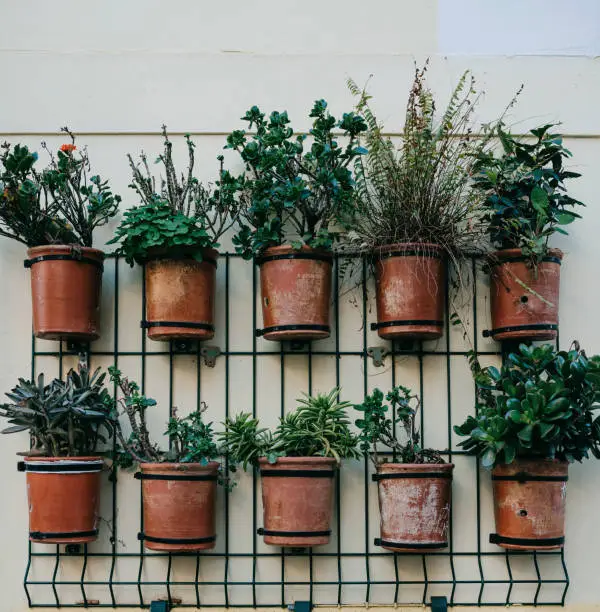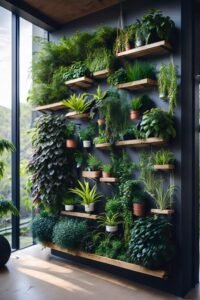Change Your City Space with Vertical Gardening

vertical garden
City life has its own set of problems such as space constraints, noise, and a scarcity of green areas. For those looking to integrate nature into their homes, vertical gardening offers an exceptional solution. Vertical or “skyscraper” style gardening enables city dwellers to cultivate marvelous green walls, fences, and gardens in even the most compact spaces. Vertical gardening can be done outdoors on a balcony or patio, or even inside the house. This style of gardening is a perfect blend of beauty and practical nature, making it ideal for city living.
How Vertical Gardening Works In Improving Urban Convenience
The ever-growing population continually increases the outdoor and green park areas. Vertical gardening is a contemporary idea which has alleviated this issue by enabling plants to be grown in places where traditional gardening methods cannot be used. Plants are now grown upwards instead of outwards, optimizing flowers for city rooftops, apartments, balconies, and high-rise buildings. Vertical gardens are not only space savers; they also serve an important purpose by filtering pollutants and enhancing air quality, and even cooling the environment through evapotranspiration. In addition, vertical gardens improve urban spaces. Walls that have long been regarded as boring are now covered with bright colors, transforming them into stunning pieces of art. These systems can also be conveniently used as green fencing that blocks out excess noise and wind, serving multiple purpose in busy urban areas.
Forms of Vertical Gardens
Forms of vertical gardening differ according to space, budget, and aesthetic appeal. One of the best examples are green walls or living walls. These are modular panels containing plants which can be grown vertically without using any floor space, as they can be mounted on walls. Vertical planters also fall into this category. These may range from sophisticated vertical racks and wall-mounted pots to simply stacked containers. These are often customizable from flowers all the way to herbs, making them a great option for DIY enthusiasts. In recent years, vertical DIY gardens have garnered a lot of attention. One can create a vertical garden using old pallets, rain gutters, wine crates and numerous other materials at very little cost.
Choosing Plants
When it comes to plants suitable for vertical gardens, a consideration of the lighting conditions, size, and local climate is necessary. Ferns, ivy, and moss can enhance shaded areas, while vibrant flowering plants along with herbs such as mint, geranium, thyme, and basil do well in full sunlight. Those herbs are ideal if you are cultivating edible plants because they are contained in smaller pots, making vertical arrangements beneficial. In addition, crops like lettuce and cherry tomatoes thrive in shallow soils and can be grown in stacked or hanging pots, making them ideal choices.

Fundamental Equipment and Supplies Required
Like any other skill, a vertical garden has a set of tools and materials and a starter kit. First, you will need vertical supports including trellises, specially designed panels, and garden netting. These supports are designed to ensure that the plants do not topple over while they grow upwards. Containers are made of wool felt and other materials that are known for their ability to contain soil and allow water to drain. Vertical gardening needs a potting mix that is light in weight while also good for vertical plants in terms of nutrition, drainage, and accessibility.
Horizontal Gardening Guide for Beginners
Horizontal gardening is not difficult. Unlike other types of gardening, it can easily be broken down into steps:
Identify the Area: Determine the best location where your vertical garden can be set up. This can include self-standing frames, walls, balcony railings and fences.
Choose the Design: Evaluate the area and decide on the kind of design you prefer to use. These can include vertical garden panels, wall-mounted planters, or even a DIY pallet system.
Get Your Planters Ready Planters, trays, and pots are mounted or fitted to provide sufficient space for plants to grow without any obstructions. Set Up the Vertical Garden Holders and Planters Soil and planters are attached to walls or other structures such that they hold vertical garden support systems. Watering and Grooming Maintaining the plants by shaping them with adequate watering and pruning into the desired outline is crucial.
Instructions for Maintaining Your Vertical Garden
Vertical gardens require meticulous attention to detail if their plants are to remain at their optimal health. The first order of business in maintaining plant health is watering, which can be greatly simplified by using a drip irrigation system or self-watering planters. In warm climates, monitoring moisture content in the soil becomes critical. Compared to traditional gardens, vertical gardens are much more susceptible to drying out due to their greater exposure to air circulation. Vertical gardening other caring tricks includes gardening pruning. Removing dead growth or any unsightly growth will enhance the growth of remaining stems by alleviating unnecessary competition. For those growing edibles, regularly harvesting leaves or fruits will encourage further growth. Additional measures to control pests must also be implemented. Urban plants are far more susceptible to pests, so check your plants frequently and deal with any issues as early as possible.
Tips For Decoration in Areas that are Limited
Vertical planting adds the green touch that small urban spaces desperately need. Here are a few tips that will help you to incorporate nature into these restricted areas.
Balcony Gardens: For an herb garden, vertical racks or plant holders may be added to balcony railings. Climbing plants like peas and beans can be grown in hanging pots or latticework.
Indoor modular panels and mounted planters provide solutions to limited green space in an apartment or office by creating vertical gardens. This method also improves air quality and has a calming impact indoors.
Repurposed Planters: Combine wine bottles, crates, and pallets into vertical gardens for a down-to-earth approach. These repurposed planters are not only affordable and eco-friendly, but also add character.
Vertical Garden Frames: A movable vertical garden frame can be placed in front of windows or adjacent to blank walls transforming neglected spots into lush green spaces aesthetically without needing any permanent installation.
Vertical gardening or “living walls,” optimizes urban life by combining horizontal and vertical space usage. It aids in the growing of cooking herbs as well as decoration, and enables one to relish the view of nature outside their windows all while conserving valuable floor space. With the proper equipment, appropriate plant selections, and low maintenance care, you can transform your urban living spaces into a delightful emerald oasis, no matter the restrictions on space. Adopt vertical gardening to enhance your compact urban residence.


